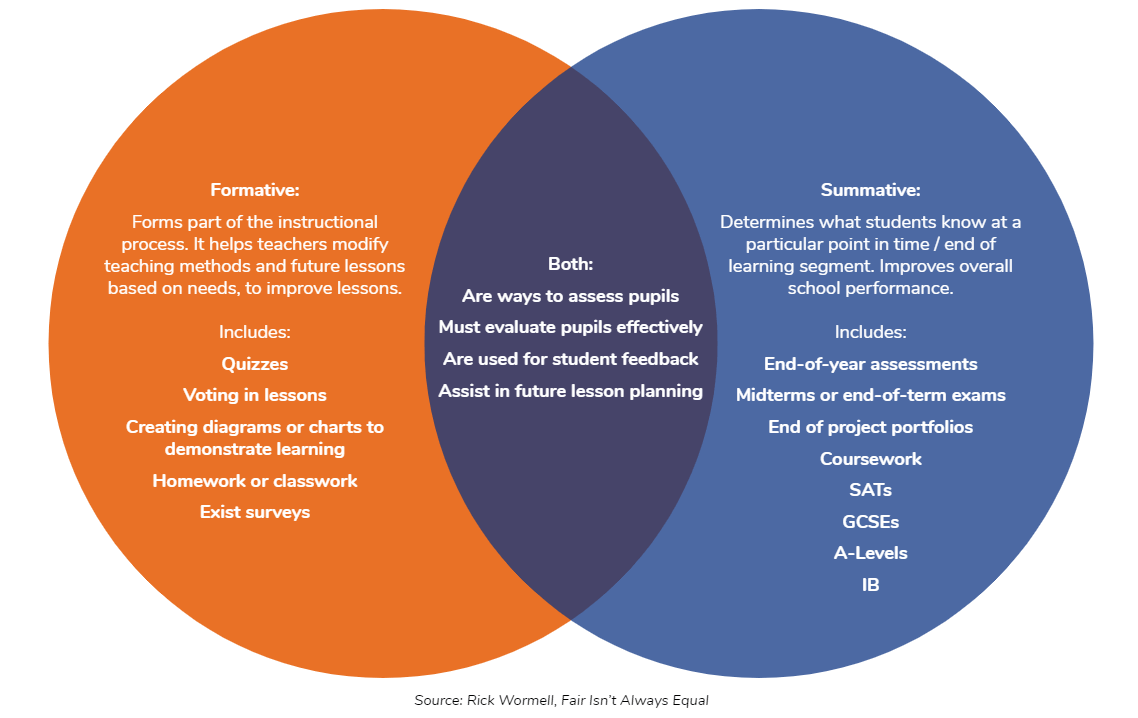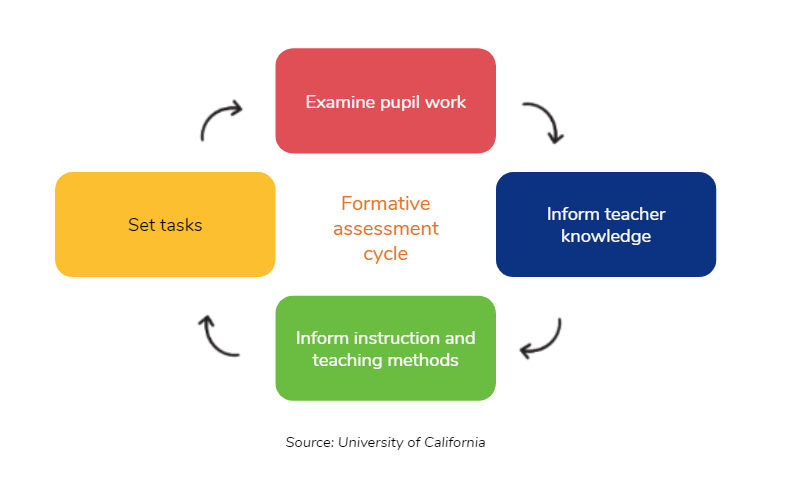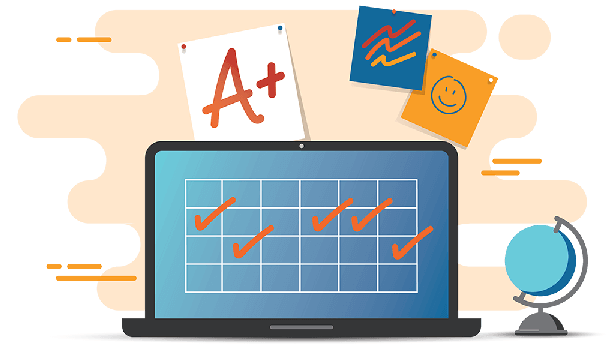Published on April 28th, 2021
Types of summative & formative assessment
14 minute read

There are two ways of assessing students — formal summative assessment and informal formative assessment. Find out the benefits of both to students’ learning outcomes.
“When the cook tastes the soup, that’s formative. When the guests taste the soup, that’s summative.” Robert E. Stake, Professor Emeritus of Education at the University of Illinois
Formative assessment and summative assessment are two overlapping, complementary ways of assessing student progress in schools. While the common goal is to establish the development, strengths, and weaknesses of each student, each assessment type provides different insights and actions for educators. The key to holistic assessment practice is to understand what each method contributes to the end goals — improving school attainment levels and individual students’ learning — and to maximize the effectiveness of each.
Both terms are ubiquitous, yet teachers sometimes lack clarity around the most effective types of summative assessment and more creative methods of formative assessment. In our latest State of Technology in Education report, we learned that more educators are using online tools to track summative assessment than formative, for example. Yet, this need not be the case. In this post, we will explain the difference between these two types of assessment, outline some methods of evaluation, and assess why both are essential to student development.
Summative assessment explained
Summative assessment aims to evaluate student learning and academic achievement at the end of a term, year, or semester by comparing it against a universal standard or school benchmark. Summative assessments often have a high point value, take place under controlled conditions, and therefore have more visibility.
Summative assessment examples:
- End-of-term or midterm exams
- Cumulative work over an extended period, such as a final project or creative portfolio
- End-of-unit or chapter tests
- Standardized tests that demonstrate school accountability are used for admissions
Why is summative assessment important for learning?
In the current education system, standard-driven instruction plays a significant role. Summative assessment, therefore, provides an essential benchmark to check the progress of students, institutions, and the educational program of the country as a whole.
Summative assessment contributes largely towards improving the curriculum and overall curriculum planning. When summative assessment data indicates gaps across the board between student knowledge and learning targets, schools may turn to improved curriculum planning and new learning criteria to assess and improve their school attainment levels.
Formative assessment explained
Formative assessment is more diagnostic than evaluative. It is used to monitor student learning style and ability, to provide ongoing feedback, and allow educators to improve and adjust their teaching methods and for students to improve their learning.
Most formative assessment strategies are quick to use and fit seamlessly into the instruction process. The information gathered is rarely marked or graded. Descriptive feedback may accompany formative assessment to let students know whether they have mastered an outcome or whether they require more practice.
Formative assessment examples:
- Impromptu quizzes or anonymous voting
- Short comparative assessments to see how students are performing against their peers
- One-minute papers on a specific subject matter
- Lesson exit tickets to summarize what students have learned
- Silent classroom polls
- Ask students to create a visualization or doodle map of what they learned
Why is formative assessment important for learning?
Formative assessment is a flexible and informal way of assessing progress and understanding of a certain subject matter. It may be recorded in a variety of ways or may not be recorded at all, except perhaps in lesson planning using tools such as ActivInspire teaching software to address the next steps.
Formative assessment helps students identify their strengths and weaknesses and target areas that need work. It also helps educators recognize where students are struggling and address problems immediately. At a school level, school leaders use this information to identify areas of strength and weakness across the institution and to develop strategies for improvement.
As the learning journey progresses, further formative assessments indicate whether teaching plans need to be revised to reinforce or extend learning.
Why is assessing student progress a challenge?
Assessment, both formative and summative, is deemed an imperative part of the education process. Unfortunately, standardized exams and informal testing in schools are also blamed for the narrowing of the curriculum and teaching methods, contributing towards damaging levels of stress among teachers and students, and only valuing specific achievements to the detriment of broader learning.
Pearson and LKMco researched the topic of assessment in schools and published a subsequent report, Testing The Water. The report was revealed that a fifth of teachers in the UK are unclear where to go for information on assessing their students. What’s more, teachers feel unsupported when it comes to training for assessment; less than half of educators received assessment training as part of their initial teacher training.
How could teacher workload be reduced?
The summative assessment procedure is tightly woven into the accountability system of teachers and schools. Teachers are often tasked and appraised based on the results of summative assessment, while schools are incentivized to achieve certain results and performance in specific areas over others.
The high-stakes nature of summative assessment translates into how the school performance is judged, and school leadership teams often pass down pressure as a result. Statutory assessment, therefore, can cause a lot of stress for students, and a high degree of pressure for teachers.
It has been suggested that government education bodies should separate student exam results from teachers’ direct performance evaluations. Summative assessment results should, rather, serve as a discussion point or a means to highlight where additional resources may be required.
At the same time, employing more formative assessments throughout the year can take the pressure off of the end-of-term assessments. This could include weekly quizzes or short lesson evaluations that can help improve student learning on the spot and increase confidence. This ensures that the final summative assessment has a positive impact on learning as well as providing students with more tools to improve throughout the term.
How does formative and summative assessment fit together?
The distinction between some types of summative assessment and formative assessment can be hard to identify. For example, schools may use benchmark testing to monitor academic progress and determine whether students are on track to mastering the material that will be evaluated on end-of-course tests.
Some educators consider these interim tests to be formative; they are diagnostic and help modify learning techniques, but others may consider them to be summative.

In our current education system, the purposes of both formative and summative assessment are not always mutually supportive.
Traditional assessment — evaluation used for summative purposes — contains key diagnostic data for teachers, but this information is perhaps too infrequent or comes too late for appropriate action. Selected response and formative written assessments, homework meanwhile, and ongoing class feedback all serve as valuable activities as part of a teacher’s evaluation toolkit if used appropriately.
Official standard results like grades A-C may symbolize achievement, yet they rarely incorporate related learning factors such as readiness to learn or motivation. What is more, grades are not explicit to student progress, nor do they provide teachers with information that might further their teaching methods.
Schools, then, should consider cutting the time teachers spend conducting summative assessments so that they can focus on conducting diagnostic, formative assessments.
Ways to use assessment to enhance learning
There are alternative ways of assessing progress and enhancing learning with summative and formative assessment.
National exams and standardized tests leave little room for adaptation or creativity, but a midterm assessment or a module final, however, could be tasked as a visual presentation, a long-form test, or an individual essay.
Technology-enhanced assessment requires students to interact with exam material in various ways — dragging and dropping answers on an ActivPanel interactive display that highlights relevant data and completing sentences or equations in a drop-down menu. This fosters students’ digital literacy and prepares them for life after education.
By allowing students to explain their material in a medium they feel comfortable with, such as on mobile devices or on an interactive front of class display like the ActivPanel Titanium interactive board, teachers get an accurate picture of their understanding. This gives a much greater opportunity for students to demonstrate their skills.
Teachers can also set final exams or assessments in a form that resembles vocational assessments or job applications. This style of assessment can cover a broad range of material and prepare older students for performance reviews and projects in a working environment, providing a stepping stone for the future.
What are the limitations?
All assessment activities have their limitations. Any individual assessment (summative or formative) can only give a snapshot of a student’s achievement on a single occasion. This may prevent teachers from drawing clear conclusions about end-to-end strengths and weaknesses.
Some teachers believe that formative assessment can impede upon lesson time itself, with a requirement to rush through learning to proceed with assessments and evaluations. Unlike summative assessment, which cumulates towards the end of a segment and is planned and prepared for, formative assessment relies upon educators to take time from their current learning schedule, even when the results lack weight in the school’s overall marks.
What’s more, with students potentially aware that this type of assessment has no bearing on their final grades, they may take formative tests less seriously. This could lead to skewed results and teachers misreading the feedback.
Summative assessment, meanwhile, has been blamed for forcing teachers to educate with no room for creativity and teaching ‘to the test’. Students may be expected to spend hours drilling specific exercises instead of other creative and engaging exercises that inspire an interest in less conventional subjects.
Getting the balance right
All types of summative assessment and informal formative assessment are essential to assessing student progress. Both contribute towards an improved outcome from the students learning and ensure a better end result.
Teachers should, however, focus as much energy and resources on formative assessment as summative, despite the lack of weight or accountability on the former. Weaving one with the other will greatly improve a pupil’s holistic ability to prepare for the end-of-term exams or other forms of standardized testing. This contributes towards superior school attainment levels and a more positive impression of your institution. Meanwhile, government education bodies should consider detaching teacher performance evaluations from summative assessment alone to give teachers more room for creative forms of formative assessment.
Overall, a comprehensive assessment program balances formative and summative student data. With this approach, educators receive the clearest insight on where a student is relative to his or her peers, their overall education goals, and US learning targets and standards.
To help support students in showing their understanding, get in touch for a free, no-obligation demo of the ActivPanel interactive display and see how it can transform your classroom environment and help with achieving your formative and summative assessment goals.






